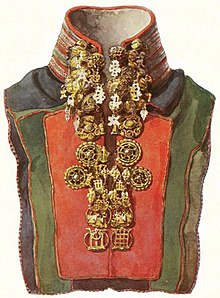


Gákti is the Northern Sámi word used by non-Sámi speakers to refer to many different types of traditional clothing worn by the Sámi in northern areas of Norway, Sweden, Finland and the Kola Peninsula in Russia. The gákti is worn both in ceremonial contexts and while working, particularly when herding reindeer. The traditional Sami outfit is characterized by a dominant color adorned with bands of contrasting colours, plaits, pewter embroidery, tin art, and often a high collar. In the Norwegian language the garment is called a 'kofte', and in Swedish it is called 'kolt'.
Characteristics
The colours, patterns and decorations of the costume can signify a person's marital status and geographical origin. There are different gákti for women and men; men's gáktis are shorter at the hem than women's. Traditionally the gákti was made from reindeer skin, but in modern times, wool, cotton or silk are more common. The gákti can be worn with a belt (pleated, quilted or with silver buttons), silver jewellery, traditional leather footwear and a silk scarf. Traditionally, if the buttons on the belt are square, it shows the wearer is married. If they are round, the person is unmarried. If a married couple divorce, and the ex-husband still continues to use the Sami costume made by his ex-wife, he states by this that he wants her back.
In other Sámi languages
"Gákti" is the Northern Sámi term for the clothing. The following terms in other Sami languages do not refer to the Northern Sami gákti, but their own clothing:
South Sámi: gaeptie/gapta/gåptoe
Ume Sámi: gápttie
Pite Sámi: gáppte, gåppto
Lule Sámi: gáppte/gábdde
Inari Sámi: mááccuh
Skolt Sámi: määccaǩ
Kildin Sámi: ма̄цэх/юххьп/юппа
Ter Sámi: ма̄ца (mā͕ᵈtsa͕ᵍ)
Fake gákti
The Finnish tourist industry is notorious for displaying fake Sámi culture for tourists. Ethnically Finnish actors dress up in fake "gáktis" and perform fake "traditional rituals". This activity has been met with fierce protests from ethnic Sámi since it creates a false image of Sámi culture, diverts tourist industry money from ethnic Sámi to ethnic Finns (thereby exploiting the Sámi presence in Lappland without giving anything back to the Sámi) and is dishonest towards tourists.
See also
External links
References
- Fra hverdagsplagg til kulturelt kjennetegn Archived 2016-08-08 at the Wayback Machine Norwegian Digital Learning Arena / Norwegian News Agency (in Norwegian)
- "gaeptie: Substantiv (N)". gtweb.uit.no (in Norwegian). Retrieved 2019-03-15.
- ^ "Pikaopas saamelaiskulttuuriin" [A quick guide to Sámi culture]. Sano se saameksi (in Finnish). Retrieved 2019-03-15.
- "Odezhda rossiyskikh saamov" Одежда российских саамов [Clothing of Russian Sami]. Saami.su (in Russian). Archived from the original on 2022-08-11. Retrieved 2023-02-17.
- "Kotimaisten kielten keskus". kaino.kotus.fi (in English, Finnish, German, and Northern Sami). Archived from the original on 2023-12-04. Retrieved 2023-12-04.
- "SÁPMI: No Fake Samis, Stop the Misuse of Our Culture". Galdu.org. 2008-10-31. Archived from the original on 2012-02-17. Retrieved 2012-10-13.
![]() Media related to Sami clothing at Wikimedia Commons
Media related to Sami clothing at Wikimedia Commons
| Folk costumes | |||||||||||||
|---|---|---|---|---|---|---|---|---|---|---|---|---|---|
| Africa | |||||||||||||
| Asia |
| ||||||||||||
| Europe |
| ||||||||||||
| South America | |||||||||||||
| North America | |||||||||||||
| Oceania | |||||||||||||